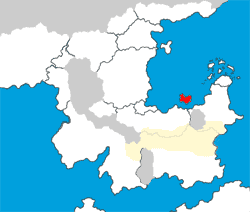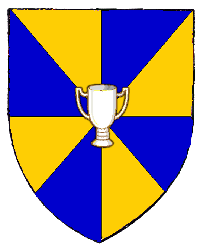Country Info: Tamplonia
 
|
| Terminology: | Tamplonian (tam-PLOH-nee-ann) people, one Tamplonian, many Tamplonians |
| Capital: | Terdosa (tair-DOH-sah) |
| Monarch: | Officially, Prince Philip II, born 939. (Philippus Princeps Tamploniae) The real power rests with Elunian Archpatriarch Paul Carlo IV (Paulus Carolus IV, Archpatriarcha Tamploniae). |
| Coat of Arms: | Gyronny of eight or and azure, a cup argent. |
For decades the princes of this balmy island have been notoriously weak. Elunian priests, counselors to the princes, have gradually expanded their influence, so that by now it is common knowledge than the Elunian church is the real ruler of the principality. The priests keep the na´ve princes pampered, content that the Elunians, holders of mystical secrets, will use their unbounded knowledge to properly guide the country. In their own defense, the Elunians have ruled relatively well, keeping the land peaceful and limiting their own abuses.
Naturally, this has influenced worship in the land, for temples to Elune dot the cities and countryside, dwarfing those of the other gods. The present head of the Elunian church in Tamplonia, Archpatriarch Paul Carlo IV, is known as a mostly virtuous figure. Under his guidance, Tamplonia helped to finance the 997 rebellion in Valenne – a wise move at the time, as the present Duke of Valenne, Lawrence the Grey, threw out the Elunians twenty-five years ago! Since the Duke of Valenne defeated the rebellion in 997, however, Tamplonia has been sullenly quiet in foreign relations.
(Despite the prominence of Elune in Tamplonia, the Elunian churches in other lands have no formal allegiance to the Tamplonian church, and many resent the prominence and influence of that group.)
Tamplonia's not especially imposing; it's a fairly small principality. However, it is an island nation. It's quite possibly the closest surviving Imperial-era port to Sturia itself. It's a theocracy (meaning lots of clerics) worshipping the goddess of knowledge (meaning lots of scholars and mages). As a result, Tamplonian naval technology is the most advanced in Hesket. Delona and Kjolnir produce more fine sailors and marines, but ship for ship, the Tamplonian navy beats all the rest.
In 1003, a Tamplonian ship, the HMS Lumen, successfully crossed the ocean to the east, bypassing the Yamamotoan islands and reaching the Dosanese mainland. There they landed on the shores of a great empire, "Meng Guo", apparently one of Yamamoto's rivals. The Lumen's crew made contact with emissaries from Meng Guo, who gave recognition to the Prince of Tamplonia. While Tamplonia is interested in returning to Meng Guo and bringing back more exotic trade goods, the Archpatriarch's functionaries seem little confident in the wisdom of risking another journey through such dangerous waters before they can make further improvements to their ships.
Monarch
Officially, Prince Philip II, born 939. The real power, of course, rests with Archpatriarch Paul Carlo IV.
Nobles
Ruled by a Prince. Standard noble is the Count, though there are not many, owing to the country's small size. There are no Dukes or Barons.
Major Cities
Terdosa is the country's largest city.
